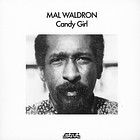He is widely regarded as a master of repetition: Mal Waldron, who would have turned 100 this August, carved out a place in music history with his rhythmic and minimalist style. Active in New York since the 1950s, he played alongside John Coltrane, Charles Mingus and Eric Dolphy, and was Billie Holiday’s regular accompanist from 1957 until her death. After a nervous breakdown in 1963, he changed course, moved to Europe two years later and eventually settled in Munich in 1967.
His album Free At Last (1969) marked not only the first release on the newly founded ECM label, but also a turning point in Waldron’s percussive playing style. That approach had fully evolved into a dense, flowing fusion groove by the time Candy Girl was recorded in France 50 years ago. Since only a tiny run was originally pressed, this session – with bassist Lafayette Hudson, drummer Donny Donable, and second keyboardist Frank Abel contributing Clavinet and Moog – is now practically being discovered for the first time.
The doubled keyboards give the tracks an understated density. Waldron lays down groove structures on the Fender Rhodes, varying them constantly, so much so that solos in the traditional sense become unnecessary. Even Brahms’ 3rd Symphony makes an appearance at the end – not pompously, but instead as pure Waldron, with just a touch more melody.

Candy Girl

